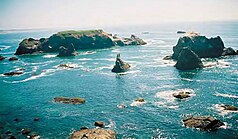California Coastal National Monument
| California Coastal National Monument | ||
|---|---|---|
| Islands and rocks off the California coast | ||
|
|
||
| Location: | California , United States | |
| Specialty: | Islands, reefs and other rock structures on the Pacific coast | |
| Next city: | Monterey | |
| Surface: | 4 km² | |
| Founding: | January 11, 2000 | |
The California Coastal National Monument is a nature reserve of the type of a national monument , which covers the entire 1350 km long Pacific coast of the US state California . The area includes all islands, rocks, reefs and other formations above the mean waterline in the twelve-mile offshore zone that are not otherwise identified. It was expelled by a Presidential proclamation on January 11, 2000 by President Bill Clinton . President Barack Obamaextended the National Monument to include land on the coast with Presidential Proclamations on March 11, 2014 and January 12, 2017. There are only areas owned by the federal government in the National Monument. As before the designation, the land is managed by the Bureau of Land Management .
description
Off the state of California, there are around 20,000 small and tiny islands, rocks and other geological formations within the coastal waters that protrude above the waterline. The average size is only 3 m². They are all year round habitat for sea birds, marine mammals and plant species adapted to the conditions. In spring and autumn they are part of the coastal bird migration route known as the Pacific Flyway , where millions of birds migrate to their breeding or wintering areas. The Channel Islands , which are otherwise designated as protected areas, and the coastal portions of other protected areas such as Redwood National Park or Point Reyes National Seashore do not belong to the protected area . Parts of the monument are surrounded by the Monterey Bay National Marine Sanctuary . A small chain of islets only 2 hectares in size south of Cape Mendocino in Northern California has also been designated as a Wilderness Area since 2006 under the name Rocks and Islands Wilderness , the strictest class of nature reserves in the United States. This makes it the smallest wilderness area in the USA.
Rare and endangered species in the area include the brown pelican , the Guadalupe fur seal , the Steller sea lion and the sea otter . An estimated 200,000 breeding pairs of seabirds breed in the reserve. Thousands of marine mammals, including seals, give birth to their young on the coastline.
There are also lighthouses that are no longer in use in the area. There is currently no visitor center in the California Coastal National Monument.
Uses
Due to the small size of the islands and the difficult accessibility, there is no tourist use. Algae are commercially harvested for food on and on some of the islands. In addition, crude oil is extracted in the coastal waters .
Web links
- Official website at the Bureau of Land Management

